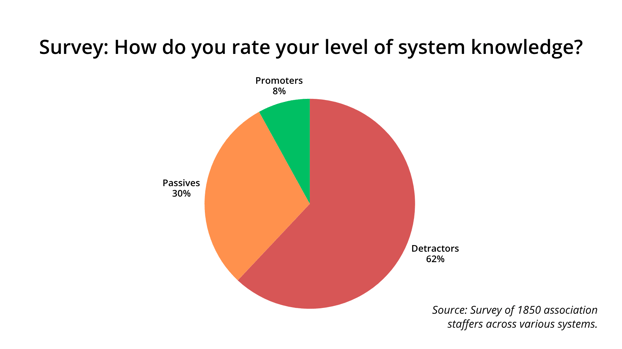When was the last time your staff received meaningful training? If you can’t remember, or if your team would say “ages ago”, you’re not alone.
But what’s the true cost of undertraining? It doesn’t show up on a budget line, but it impacts everything from staff morale to goal achievement. For associations, unions, and nonprofits, where team capacity is closely tied to mission impact, overlooking staff development is a risk you can’t afford.
Here’s how undertraining silently chips away at your success.
The statistics and 🗨️ quotes in this article come from a survey of 1,850 association staffers, where 62% say they are not confident in their system knowledge.

Hidden Costs of Undertraining Staff at Associations, Unions, and Nonprofits

1. Staff Stay in Their Comfort Zones
When training is limited, staff tend to only use what they know, and nothing more. That might sound harmless, but over time, it creates a culture where innovation stalls and growth is stifled.
They try things until something works, not necessarily the right way, and repeat that going forward.
As one staff member put it:
Without the confidence that comes from structured learning, even well-intentioned employees avoid trying new tasks or exploring features within your systems. You end up with siloed knowledge and missed efficiencies, all because people don’t feel equipped to go beyond the basics.

2. No Clear Path to Growth or Improvement
Even high-potential staff can plateau if there’s no regular cadence for learning or professional development.
Lack of ongoing learning discourages staff from growing into new roles or taking ownership of key systems. Want to create a culture where growth is the norm? Start by rethinking how your organization approaches training at every level.
3. Disengagement Leads to Turnover
Staff who don’t feel supported in their roles eventually become unmotivated. When employees think they’re not growing, they may start looking elsewhere or mentally checking out.
This kind of dependency culture increases burnout among more knowledgeable staff while eroding overall team morale. Training isn’t just about knowledge, it’s about investing in your people so they feel confident and valued.

4. Missed KPIs and Underperforming Systems
Your systems and teams won’t perform to their full potential if staff training isn't a priority. Technology is a critical part of member engagement, operations, and decision-making. If staff don’t know how to use it effectively, you're leaving value on the table.
Worse, this gap makes it harder to reach strategic goals. Undertraining creates inefficiencies that ripple across departments and initiatives. Missed deadlines, inconsistent data, and frustrated members are just some of the downstream effects.
Don’t let undertraining limit your impact.
 In the 5th edition, ASI Chairman & CEO Bob Alves and President & CTO Don Robertson provide the latest insights and best practices to optimize operational performance, increase revenue, and ensure continuous performance improvement.
In the 5th edition, ASI Chairman & CEO Bob Alves and President & CTO Don Robertson provide the latest insights and best practices to optimize operational performance, increase revenue, and ensure continuous performance improvement.
Conclusion: Build Confidence, Build Capacity
Poor staff education isn’t just a staffing issue, it’s an organizational risk. When staff lack confidence, they hesitate. When they feel unsupported, they disengage. And when your team doesn’t grow, neither does your mission.
The good news? You don’t need a massive training overhaul to get started. Even small, consistent investments in learning, like periodic system refreshers or mentorship pairings, can go a long way in building engagement and performance.
Want to know what your staff really need? Ask them. And then, most importantly, give them the tools to succeed.